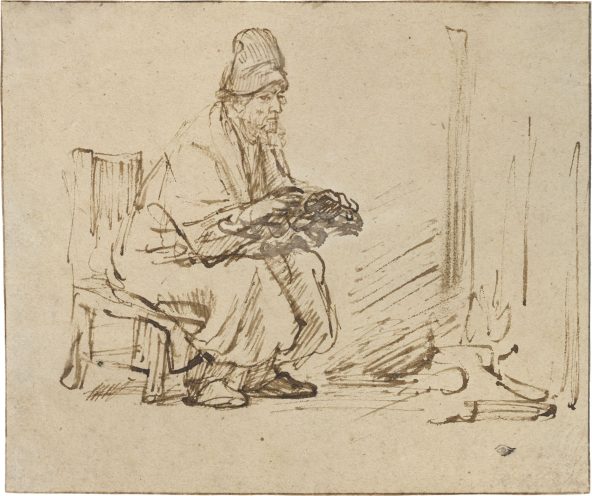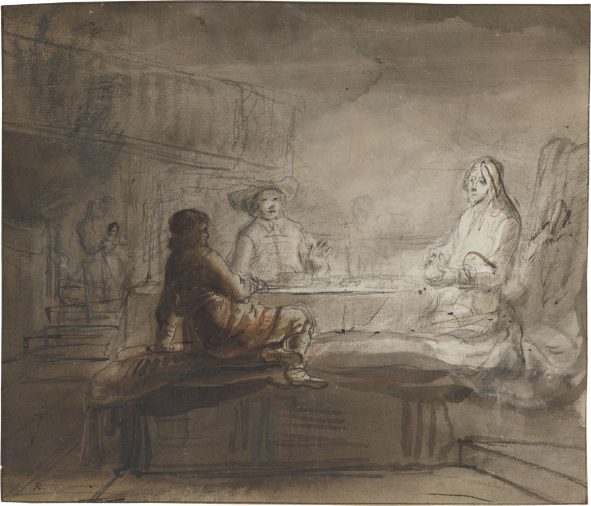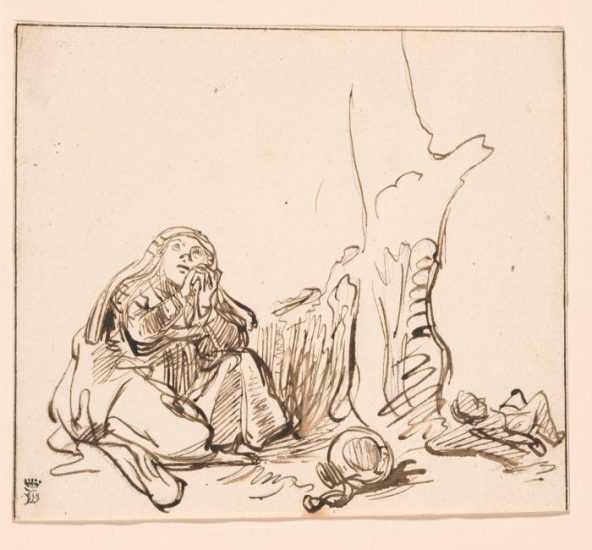Article: Rembrandt and His Circle
Focus on the Peck Feature
2019 marks the 350th anniversary of Rembrandt van Rijn’s death (1606-1669), an event celebrated through exhibitions and programs worldwide. The Ackland’s contribution to these festivities is a Focus on the Peck Collection installation featuring three drawings — one created by Rembrandt, one made by a student with Rembrandt’s corrections, and one produced by an unknown follower — that demonstrate both Rembrandt’s skill as a draftsman and teacher and distinguish his drawing style from that of his circle.
One of the glories of the Peck Collection at the Ackland are the seven drawings by Rembrandt van Rijn (1606 – 1669), the greatest artist of the Dutch Golden Age. 2019 marks the 350th anniversary of the artist’s death, an event celebrated through exhibitions and programs worldwide. The Ackland’s first contribution to these festivities is this installation of three drawings — one created by Rembrandt, one made by a student with Rembrandt’s corrections, and one produced by an unknown follower.
Drawing formed an integral part of Rembrandt’s artistic practice, allowing him to refine his skills, to work out compositions, and to record interesting motifs. Drawing also served as a key component of Rembrandt’s teaching process. His numerous pupils and assistants learned to imitate their master’s style and technique by copying Rembrandt’s drawings and by generating adaptations of his existing compositions. As a result, Rembrandt and his circle created thousands of drawings, many of which have survived. Out of this vast number, only a small percentage bear Rembrandt’s signature or his handwritten inscriptions, making the task of distinguishing Rembrandt’s drawings from those of his skilled students and imitators an ongoing pursuit among scholars.
This Focus on the Peck Collection installation invites attention to these attribution questions. Consider the technique and style of each of the works and see if you can discern Rembrandt’s manner of drawing from that of his followers?
A Seated Old Man Warming his Hands by a Fire

Rembrandt van Rijn, Dutch, 1606 – 1669, A Seated Old Man Warming his Hands by a Fire, c. 1650, pen and brown ink with white gouache. The Peck Collection, 2017.1.66
See A Seated Old Man Warming his Hands by a Fire in more detail here.
Rembrandt’s drawing of an old man warming himself by the fire, demonstrates his use of lead-white wash to edit his work. Dissatisfied with the first rendition of the figure’s hands low against his lap, Rembrandt amended his sketch so they appear higher. The white overlay now looks cloudy from oxidation.
The Supper at Emmaus

Constantijn van Renesse, Dutch, 1626 – 1680, retouched by Rembrandt van Rijn, Dutch, 1606 – 1669, The Supper at Emmaus, c. 1650-52, pen and black ink, brown and gray wash, over black and red chalk. The Peck Collection, 2017.1.69
See The Supper at Emmaus in more detail here.
Rembrandt also edited his pupil’s works. In Constantijn van Renesse’s drawing of Christ’s post-resurrection interaction with his followers, in the center, Rembrandt added quick pen strokes to sharpen Jesus’s features, lengthen his hair and beard, shorten his torso, and change his arm position.
Hagar and Ishmael, copy after Rembrandt’s Hagar and Ishmael in the Wilderness

after Rembrandt van Rijn, Dutch, 17th century, Hagar and Ishmael, copy after Rembrandt’s Hagar and Ishmael in the Wilderness, 1630s, pen and brown ink over graphite. Gift of Leena and Sheldon Peck in memory of Sylvia and Max A. Peck, 94.7
Drawing was an integral part of Dutch seventeenth-century workshop practice and the biblical subject of Hagar and her son Ishmael in the wilderness was a frequently illustrated subject by Rembrandt and his pupils. In the drawing above, the presence of an underdrawing, combined with the anatomical uncertainty and unconvincing suggestion of space, indicate this drawing was created by someone attempting to emulate Rembrandt’s style.


